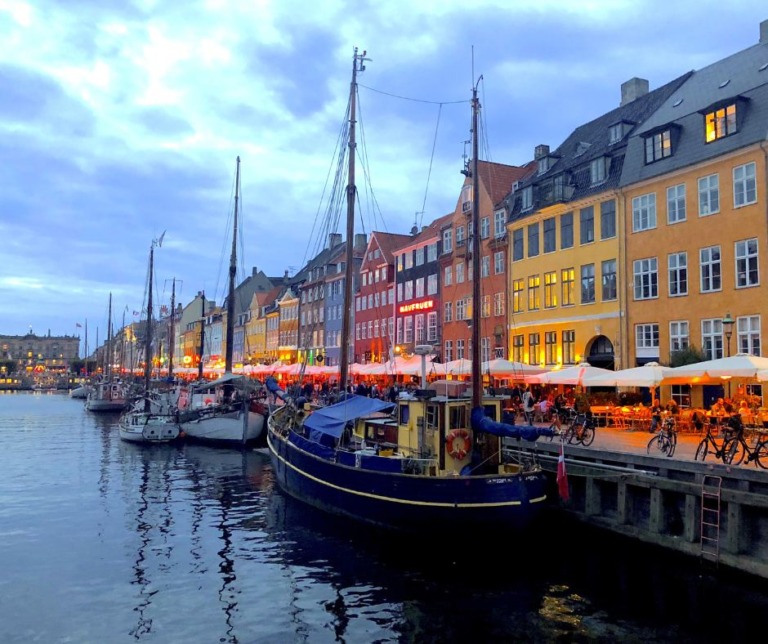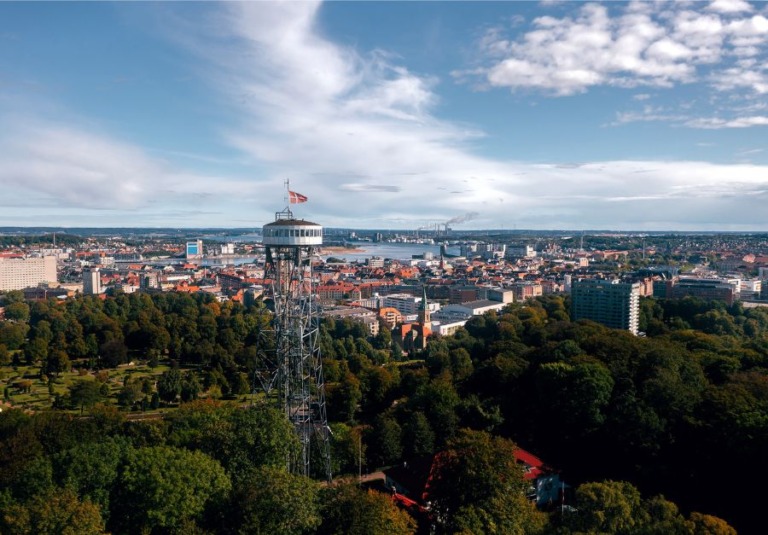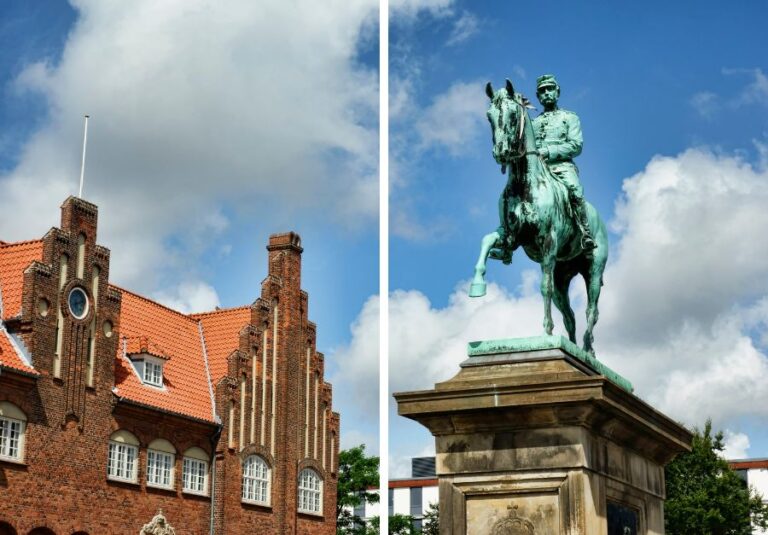Fancy a city break in Denmark? To help you plan your trip, here are the biggest Danish cities, plus some other interesting ones to consider.
Since moving to Norway, I've spent a lot of time traveling around Scandinavia. From the fjords of Norway to the charming streets of Stockholm, Scandinavia's cities are endlessly fascinating. Sometimes, I just want something a bit different.

Denmark is easy to reach from Norway. From Oslo or Stavanger, it's a short flight, or you can take a ferry from Kristiansand to Hirtshals. This makes planning a city break in Denmark straightforward and often quicker than reaching some Norwegian cities.
What to Expect in Danish Cities
Denmark shares much in common with its Scandinavian neighbours. There's a shared history, similar languages, and a comparable way of life. Yet, by visiting Denmark's cities, you start to notice the unique charm and distinct differences.
Despite this, there's a familiar feeling in Danish cities that makes a city break across the border a comfortable experience.
Efficient public transport? Check. Cozy cafes and delicious pastries? Check. Well-maintained public spaces? Check. Nature within easy reach? Check.
If you want to broaden your travel horizons and experience more of Scandinavia, Danish cities are a great place to start. Let’s kick things off by taking a look at the five biggest.
Copenhagen
As the capital city, Copenhagen is often the first destination for many travellers. Spread across several islands, it offers a mix of modern and historical attractions, making it a vibrant city to explore.
The city’s historic centre, Indre By, features cobblestone streets and picturesque buildings. Key landmarks include Tivoli Gardens, one of the world's oldest amusement parks, which opened in 1843.

Tivoli enchants visitors with its rides, gardens, and seasonal events like Halloween and Christmas markets. It's a fun place to be for all ages, whether you want to enjoy a rollercoaster or a relaxing stroll through the gardens.
Another iconic attraction is the Little Mermaid statue, inspired by Hans Christian Andersen’s fairy tale. This bronze sculpture, perched on a rock at the Langelinie promenade, has become a city symbol and a must-see.
For a unique experience, visit Freetown Christiania, a self-proclaimed autonomous neighbourhood known for its alternative lifestyle and vibrant art scene. It does have a reputation for illegal activities, but local are making an effort to clean up the neighbourhood by closing down the so-called ‘Pusher Street'.
Nyhavn, with its colourful 17th-century waterfront houses and lively atmosphere, is another highlight. Originally a busy commercial port, Nyhavn is now a picturesque area filled with restaurants, bars, and cafes. It’s the perfect spot to enjoy a traditional Danish open-faced sandwich, known as smørrebrød.
For culture lovers, Copenhagen offers a wealth of museums and galleries. The National Museum of Denmark provides an in-depth look at the country’s history, while the Louisiana Museum of Modern Art, located just outside the city, houses an impressive collection of contemporary art.
Copenhagen's commitment to sustainability is evident throughout the city. Bicycles outnumber cars, and the extensive network of bike lanes makes it easy to explore on two wheels.
The city's parks, such as the King's Garden, the Botanical Garden, and Amager Nature Park, provide lush green spaces for relaxation and recreation.
Food enthusiasts will find Copenhagen a culinary delight. The city is home to numerous Michelin-starred restaurants, including Noma, which has been repeatedly named the best restaurant in the world.
Aarhus
Aarhus, Denmark's second-largest city, is renowned for its youthful energy, largely due to its vibrant student population.

This dynamic city offers a fascinating blend of modern architecture and historical sites, making it a compelling destination for visitors.
One of the city's standout attractions is the ARoS Aarhus Art Museum. Known for its striking rainbow-coloured walkway, the museum offers panoramic views of the city and houses an impressive collection of contemporary art.
Another must-visit is Den Gamle By, an open-air museum that provides a captivating glimpse into Denmark's past. This museum features reconstructed historic buildings, allowing visitors to experience Danish life from the 18th to the 20th centuries.
Aarhus is not just about urban attractions; it also boasts beautiful beaches and lush forests nearby. These natural landscapes make it easy to combine city life with outdoor activities.
Odense
Odense, located on the island of Funen, is best known as the birthplace of Hans Christian Andersen.

The city's rich literary heritage is celebrated through numerous museums and attractions dedicated to the famed fairy tale author.
The Hans Christian Andersen Museum, along with his childhood home, offers a fascinating look into the life and works of Andersen, providing an immersive experience for visitors of all ages.
Odense Zoo is another popular destination, renowned for its impressive exhibits and dedication to conservation efforts. The zoo's diverse array of animals and interactive exhibits make it a favourite among families and animal lovers.
The city’s charming streets, adorned with half-timbered houses, and its vibrant cultural scene make Odense a delightful place to explore. The city centre is bustling with cafes, shops, and art galleries, reflecting a blend of historical charm and contemporary flair.
Aalborg
Aalborg, in northern Jutland, boasts a rich Viking history and a thriving cultural scene.

The city’s waterfront area, featuring the striking Utzon Center designed by the architect of the Sydney Opera House, is a testament to Aalborg’s blend of old and new. This cultural centre hosts exhibitions and events that draw both locals and tourists.
The Aalborg Historical Museum offers an in-depth look at the city’s past, while the Viking burial site at Lindholm Høje provides insights into the region’s ancient history.
Held every May, Aalborg Carnival is one of the largest such events in Scandinavia, is a vibrant celebration that fills the streets with colourful parades and lively performances.
Esbjerg
Esbjerg, a key port city on the west coast, is known for its maritime heritage and as a gateway to the North Sea.
The ‘Men at Sea' monument, depicting four giant white men looking out to sea, is a striking landmark that symbolises the city's connection to the ocean.
The Fisheries and Maritime Museum offers fascinating insights into the region's maritime history and the North Sea's marine life, featuring aquariums, exhibits, and historical ships.

Esbjerg also serves as a starting point for trips to the nearby Wadden Sea National Park, a UNESCO World Heritage site renowned for its unique tidal flats and diverse birdlife, providing ample opportunities for nature enthusiasts to explore.
Other Notable Danish Cities
While the biggest cities offer plenty to see and do, there are many smaller Danish towns and cities worth considering for a visit.
These places often offer unique historical, cultural, and natural attractions that provide a deeper insight into Denmark's diverse heritage.
Roskilde
Roskilde, just a short trip from Copenhagen, is famous for its annual music festival, one of the largest in Europe, attracting music lovers from all over the world. The city is also home to the Viking Ship Museum, which showcases five original Viking ships discovered in the nearby fjord.
Roskilde Cathedral, a UNESCO World Heritage site, is another significant attraction. This Gothic cathedral, dating back to the 12th century, is the final resting place of many Danish kings and queens and offers a fascinating glimpse into the country's royal history.
Helsingør
Helsingør, also known in English as Elsinore, is home to Kronborg Castle, the setting for Shakespeare's Hamlet.
This impressive Renaissance castle, a UNESCO World Heritage site, offers fascinating tours and stunning views of the Øresund Strait. Visitors can explore the castle's grand halls, royal chambers, and the eerie underground casemates.
The town itself, with its charming streets and maritime heritage, adds to the appeal of a visit to Helsingør.
Skagen
Skagen, at Denmark’s northernmost tip, is renowned for its unique light, which has attracted artists for centuries. The meeting point of the North Sea and the Baltic Sea at Grenen is a natural wonder, where visitors can stand with a foot in each sea.
Skagen's beautiful beaches and charming town centre make it a popular destination. The Skagen Museum showcases works from the famous Skagen Painters, a group of Scandinavian artists who were inspired by the area's distinctive light and landscapes.
Ribe
Ribe, Denmark’s oldest town, is a charming destination with well-preserved medieval architecture. The Ribe Viking Center offers an immersive experience into the Viking Age, with reconstructed buildings and living history demonstrations.
Ribe Cathedral, with its striking Romanesque architecture, is another highlight. Visitors can climb the cathedral's tower for panoramic views of the town and surrounding countryside.
Ribe's cobblestone streets, lined with half-timbered houses and quaint shops, are perfect for a leisurely stroll, offering a glimpse into Denmark's rich history.
Which are your favourite Danish cities, and why? I’d love to hear your thoughts and experiences down in the comments.

